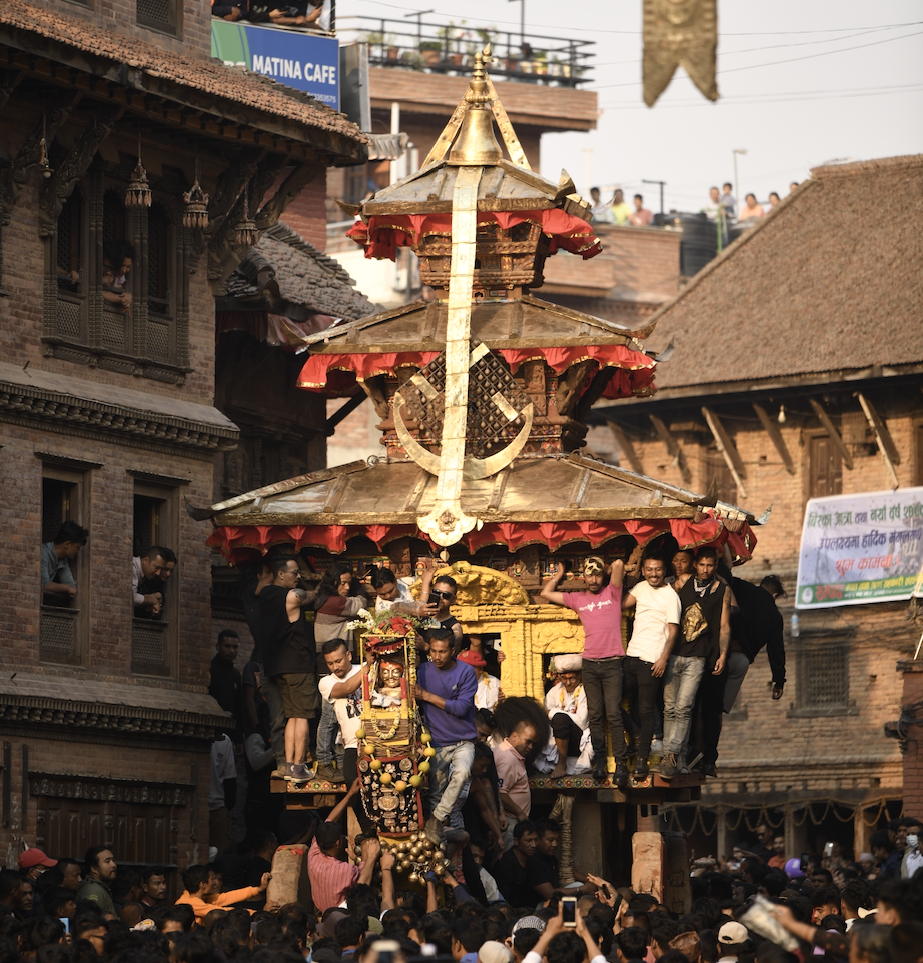Visual Feast of Bhaktapur’s Streets : Bisket Jatra
Bhaktapur, an ancient city, comes alive during Bisket Jatra with clouds of sindoor (vermillion powder), traditional music, and jubilant celebrations. Known for its enthusiastic and cultural richness, this Jatra offers a mesmerizing glimpse into the heart

BHAKTAPUR, a city where history breathes - through its ancient courtyards and timeworn bricks, comes alive each year in an eruption of color, energy, and devotion. The arrival of Bisket Jatra transforms its labyrinthine streets into a stage where mythology meets raw human passion, and tradition pulses through the veins of its people. This is more than a festival—it is a visceral experience, a story told through the clash of chariots, the fall of a towering Linga, and the ecstatic cries of a city revealing its heritage.
A Myth Woven in Time
A long time ago in Bhaktapur, there was a princess who had a strange problem—every man who married her died the very next morning! People were scared, but one brave young man decided to find out why. On their wedding night, he stayed awake and saw two tiny snakes crawl out of the princess’s nose! He quickly killed them, breaking the curse. To celebrate this victory over evil, the people started Bisket Jatra. Today, the festival is filled with chariot pulling, pole raising, music, and joy!
The very essence of this story diffuses through every ritual, every cheer, and every bead of sweat trickling down the faces of the festival’s participants. It is a battle of renewal, a conquest of light over darkness, of life over death.
The Chariot Clash – A Dance of Power and Devotion
The raw, untamed spirit of Bisket Jatra explodes into the streets with the Bhaila Dyah (Bhairav) chariot procession. Towering wooden chariots, painstakingly crafted by skilled artisans, are paraded through Bhaktapur’s ancient alleys, carried not on wheels but on the shoulders of men ignited by the fever of tradition and devotion.
The most intense and chaotic event takes place at Taumadhi Square, where the chariots engage in a fierce tug-of-war between the residents of the eastern and western parts of the city Tugged and wrenched in opposite directions by two competing groups, these mammoth structures sway, heave, and crash against the frenzied roars of thousands. Every man who grips the chariot is more than a participant—he is a guardian of his ancestors, a pillar of centuries-old honor. This is not just a contest of strength; it is an assertion of identity, a dance of power and devotion, played out on an ancient battlefield of bricks.
The Linga’s Rise and Fall – A Cosmic Transition
As the festival climaxes, the anticipation in the air is palpable. Eyes fixated on the mighty Yasin linga (pole), standing defiant against the sky. When the moment of reckoning arrives and the Linga crashes to the earth, a collective gasp rises from the throats of thousands. It is an acknowledgment that the old year has crumbled, making way for the new. A spiritual weight is lifted, and the world exhales in celebration.
The Colorful Chaos – A Symphony of Joy
Bisket Jatra is not merely seen; it is felt in the rush of wind as chariots thunder past, in the splash of sindoor (vermillion powder) across faces glowing with euphoria, in the laughter that spills over cups of thwon (local rice beer). The streets morph into a canvas where every passerby becomes an artist, smearing hues of red and orange onto strangers, transforming the city into a living, breathing artwork.
The visual intensity of the festival is matched only by the sounds that echo through the city. The rhythmic beat of traditional drums (dhimey and nyakhin) and the collective cheers of revellers amplify the pulsating energy of the moment. The entire cityscape becomes a stage where history and culture intertwine in a hypnotic display of faith and unity.
A Legacy Carved in Stone and Flesh
For the people of Bhaktapur, Bisket Jatra is more than a festival—it is a binding thread in the fabric of their identity. It is proof that no matter how the world changes, some traditions remain unshaken, roaring defiantly against the tide of modernity.
Generations stand side by side—grandparents recounting the tales of their youth, children marvelling at the spectacle before them, their eyes wide with the same wonder that once sparkled in the eyes of their ancestors. In this festival, time folds in on itself, the past and present entwined in a dance as ancient as the city itself.
The night hums with the echoes of drumbeats, the air thick with the scent of oil lamps and burning incense. Each push and pull of the chariots is a heartbeat, each moment a spectacle of human endurance, collective will, and divine play.


